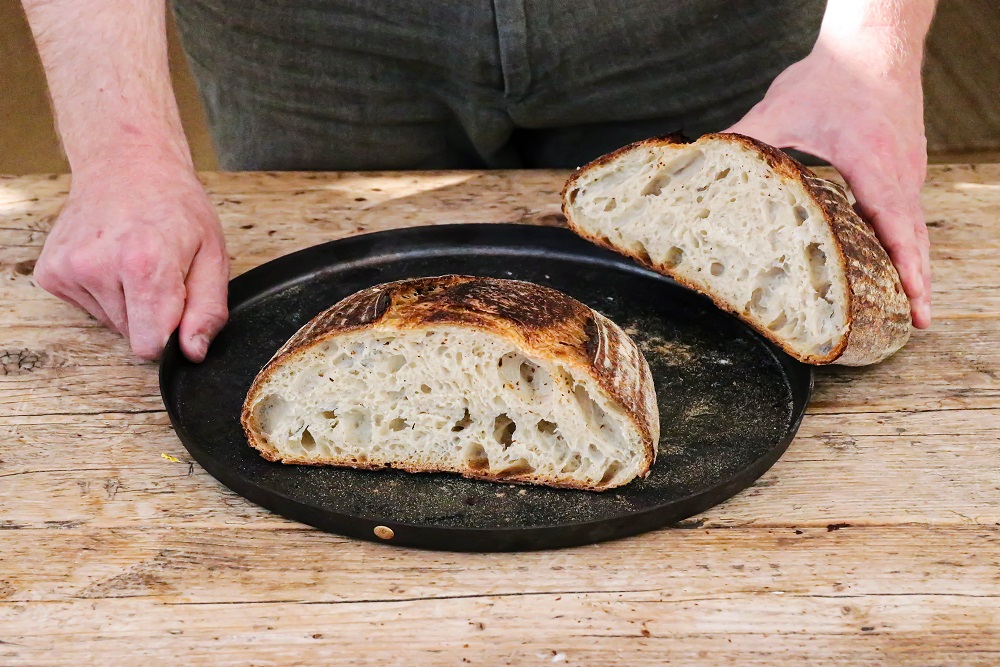There’s nothing quite like the smell of freshly baked bread, especially when it comes to sourdough. But have you ever wondered how to make that tangy and crusty loaf at home? Look no further, because we’ve got you covered! In this blog post, we’ll guide you through the steps needed to make your own homemade sourdough bread from scratch. Whether you’re a seasoned baker or a beginner looking for a new challenge, follow along with our tips and tricks for delicious results every time. Let’s get baking!
What You Need to Make Sourdough Bread
To make homemade sourdough bread from scratch, you’ll only need a few ingredients and tools. First off, you’ll need flour, preferably unbleached all-purpose or bread flour. You can also use whole wheat or rye flour to add more flavor to your bread.
Next, you’ll need water that is free from chlorine and other chemicals. Chlorinated water can kill the natural yeast in your sourdough starter.
Now let’s talk about the star of the show – the sourdough starter! This mixture of flour and water will ferment over time and create natural yeasts that will help leaven your bread dough. You can either make a new one or buy it online if you don’t have an existing one.
A good kitchen scale is essential for measuring precise amounts of ingredients as baking requires accuracy. A mixing bowl, wooden spoon or spatula, plastic wrap or cloth towel are also necessary to get started on making your own delicious loaf of sourdough bread.
Having a Dutch oven with a lid is recommended because it creates steam inside while baking which helps form a nice crispy crust on top of your loaf!
With these simple tools and ingredients at hand, you’re ready to start making homemade sourdough bread like a pro!
The Steps to Making Sourdough Bread
Making sourdough bread from scratch may seem like a daunting task, but it’s surprisingly simple once you get the hang of it. Here are the steps to making delicious homemade sourdough bread:
1. Start with a sourdough starter – this is what gives the bread its signature tangy flavor and chewy texture. You can make your own starter by mixing equal parts flour and water and letting it sit out for a few days to ferment.
2. Mix together your dough – combine flour, salt, water, and your sourdough starter in a large bowl until everything is well incorporated.
3. Knead the dough – turn the dough out onto a floured surface and knead for 10-15 minutes until it becomes smooth and elastic.
4. Let it rise – place the dough into an oiled bowl, cover with plastic wrap or a damp towel, and let it rise at room temperature for several hours or overnight.
5. Shape your loaf – gently deflate the risen dough, shape it into a ball or oblong loaf depending on your preference, then place onto parchment paper lined baking sheet.
6. Bake! Preheat oven to 450°F (230°C) degrees which should take about 20 minutes while you let shaped loaf rest during that time before placing in oven for about 30-35 minutes covered with foil first then remove foil last 10 minutes so crust forms nicely on top of bread.
With these simple steps under your belt, you’ll be able to bake beautiful loaves of homemade sourdough bread anytime you want!
Tips for Making the Perfect Sourdough Bread
Making the perfect sourdough bread can be a challenging task, but with some helpful tips, you can achieve bakery-quality results right in your own kitchen. Here are some essential tips for making great sourdough bread.
1. Use quality ingredients: The better the quality of your flour and water, the better your final product will be. Choose organic or unbleached flours and filtered or purified water to give your bread a superior flavor.
2. Be patient: Sourdough requires time to develop its flavors and texture. Don’t rush the process by increasing fermentation temperatures or not allowing enough time for bulk fermentation. Follow the recipe closely and allow sufficient time at each stage.
3. Maintain consistency: Consistency is key when it comes to sourdough baking. Measure ingredients carefully using a kitchen scale rather than volume measurements for accuracy.
4. Experiment with hydration levels: Hydration refers to how much water is added relative to flour weight in dough recipes – it’s important to get this measurement just right as it affects both texture and taste of your loaf.
5.
Bake at high temperatures: To get that signature crispy crust on your sourdough bread, bake at high heat between 450-500°F (230-260°C)for about 30 minutes before reducing temperature further until done.
By following these simple tips, you’re sure to produce delicious homemade sourdough loaves that rival those from professional bakeries!
Different Types of Sourdough Bread
Sourdough bread is not a one-size-fits-all type of bread. It comes in different varieties and can be customized to suit your taste preferences. Here are some types of sourdough bread you may want to try:
1. Classic White Sourdough – This is the most basic sourdough bread made from flour, water, salt, and starter culture.
2. Whole Wheat Sourdough – Made from whole wheat flour, this bread has a nutty flavor and denser texture compared to classic white sourdough.
3. Rye Sourdough – Using rye flour instead of wheat gives this bread a distinctive tangy taste with hints of bitterness.
4. Spelt Sourdough – Spelt flour has a sweeter flavor than wheat or rye which makes for an interesting twist on traditional sourdough.
5. Multigrain Sourdough – Adding seeds, nuts or grains like sunflower seeds, flaxseeds or oats creates extra crunchiness and nutrition into your loaf.
Experimenting with different combinations of ingredients will allow you to create unique flavors that match your personal preference!
How to Store Sourdough Bread
Once your homemade sourdough bread is ready, you’ll want to store it properly to keep it fresh and delicious. The good news is that sourdough bread has a longer shelf life than other types of bread due to its natural acidity.
To start, let your bread cool completely before storing it. This will prevent condensation from forming inside the storage container and making the bread soggy.
The best way to store sourdough bread is in a paper bag or wrapped in a clean kitchen towel. Avoid using plastic bags as they can trap moisture and cause mold growth.
If you need to extend the shelf life of your sourdough even further, consider freezing it. Slice the loaf into individual portions and wrap them tightly in plastic wrap or aluminum foil before placing them in an airtight container or freezer bag. Sourdough can last for up to 3 months when stored this way.
When you’re ready to enjoy your frozen sourdough, simply remove the desired number of slices from the freezer and allow them to thaw at room temperature for several hours before reheating them in the oven for that freshly baked taste.
Conclusion
Making homemade sourdough bread from scratch may seem intimidating, but with the right ingredients and steps, it’s actually quite simple. By following this guide, you can create delicious loaves that are full of flavor and nutrition.
Remember to take your time with each step, as sourdough requires patience and attention to detail. Don’t be afraid to experiment with different types of flour or variations in fermentation times to find what works best for you.
With practice, you’ll soon become a master at making your own sourdough bread that will impress friends and family alike. So roll up your sleeves and get ready to enjoy the satisfying taste of warm, fresh-from-the-oven bread – made entirely by you!








